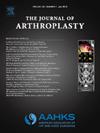身体质量指数并不是原发性全关节置换术患者切口周围肥胖状况的适当替代物。
IF 3.4
2区 医学
Q1 ORTHOPEDICS
引用次数: 0
摘要
背景:美国矫形外科医师学会(AAOS)将择期安全手术的可接受阈值定义为体重指数(BMI)低于 40,因为这样会增加并发症的风险。这一建议的后果是以体重指数为硬性界限,限制了越来越多的不同人群接受治疗。人们越来越清楚地认识到,过多的脂肪组织会通过机械和生理机制增加术后并发症(包括感染)的风险。但目前还不清楚体重指数(BMI)是否是衡量全关节成形术(TJA)患者脂肪含量的准确指标,因此也不清楚体重指数是否能捕捉到肥胖患者的临床相关信息。我们的目的是在一系列连续的不同初诊 TJA 患者中确定切口周围脂肪含量(PIA)与 BMI 之间的关系:方法:我们对一系列连续的原发性 TJA 患者进行了术前评估。对每位患者收集了以下变量:结果:在 THA 患者(99 人 = 99 例)中,PIA 的测量值为 0.5,BMI 的测量值为 0.5,PIA 的测量值为 0.5:在 THA 患者(99 人)中,皮尔逊相关系数(r)= 0.436,这表明 BMI 与脂肪之间存在中度相关性。在 TKA 患者(271 人)中,股骨 PIA(FPIA)的相关系数为 0.395,胫骨 PIA(TPIA)的相关系数为 0.249,这表明 BMI 与射线照相测量的脂肪含量之间存在微弱的相关性。在 TKA 患者中,FPIA 的 r = 0.560,TPIA 的 r = 0.544,这表明 BMI 与超声波测量的脂肪含量之间存在中度相关性:结论:肥胖量化已成为初治 TJA 患者术前评估的常见做法。其目的是确定脂肪组织的大小,因为脂肪组织是肥胖症术后并发症的主要诱因之一。BMI 因其获得和计算简单而被普遍用作肥胖的替代指标。我们的报告显示,在这一人群中,BMI 与切口周围脂肪含量的关系为弱至中等。这些研究结果表明,BMI 可能无法准确代表切口周围脂肪组织的状况,因此无法捕捉到相关的肥胖数据,用于对初级全关节成形术患者进行术前风险分层。本文章由计算机程序翻译,如有差异,请以英文原文为准。
Body Mass Index is Not an Appropriate Proxy for the Condition of Peri-Incisional Adiposity in Primary Total Joint Arthroplasty Patients
Background
The American Academy of Orthopaedic Surgeons defined the acceptable threshold for elective safe surgery as a body mass index (BMI) under 40 due to the increased risk of complications. A consequence of this recommendation has been a hard cutoff based on BMI, which restricts access to care for an increasingly large and diverse population. There is an improved understanding that excess adipose tissue confers additional risk for postoperative complications, including infection, through mechanical and physiologic mechanisms. But, it is unclear if BMI is an accurate indicator of adiposity in total joint arthroplasty (TJA) patients and, thus, whether BMI is capturing clinically relevant information in obese patients. Our objective was to determine the relationship between peri-incisional adiposity (PIA) and BMI in a consecutive series of diverse primary TJA patients.
Methods
A consecutive series of patients indicated for primary TJA were preoperatively evaluated. For each patient, the following variables were collected: BMI and measures of PIA on radiographs and ultrasounds.
Results
In THA patients (N = 99), Pearson’s correlation coefficient (r) = 0.436, which indicates a moderate correlation between BMI and adiposity. In total knee arthroplasty patients (N = 271), r = 0.395 for femoral PIA (FPIA) and r = 0.249 for tibial PIA, which indicates a weak correlation between BMI and adiposity measured on radiography. In total knee arthroplasty patients, r = 0.560 for femoral PIA and r = 0.544 for tibial PIA, which indicates a moderate correlation between BMI and adiposity measured on ultrasound.
Conclusions
Quantification of obesity has become a common practice in the preoperative evaluation of primary TJA patients. The intent is to determine the magnitude of adipose tissue, which is one of the main drivers of postoperative complications in obesity. The BMI is ubiquitously used as a proxy for obesity due to its simplicity of attainment and calculation. We report that BMI has a weak-to-moderate association with PIA in this population. These findings indicate that BMI may not accurately represent the condition of peri-incisional adipose tissue and, thus, is not capturing the relevant obesity data for preoperative risk stratification in primary TJA patients.
Level of evidence
III.
求助全文
通过发布文献求助,成功后即可免费获取论文全文。
去求助
来源期刊

Journal of Arthroplasty
医学-整形外科
CiteScore
7.00
自引率
20.00%
发文量
734
审稿时长
48 days
期刊介绍:
The Journal of Arthroplasty brings together the clinical and scientific foundations for joint replacement. This peer-reviewed journal publishes original research and manuscripts of the highest quality from all areas relating to joint replacement or the treatment of its complications, including those dealing with clinical series and experience, prosthetic design, biomechanics, biomaterials, metallurgy, biologic response to arthroplasty materials in vivo and in vitro.
 求助内容:
求助内容: 应助结果提醒方式:
应助结果提醒方式:


